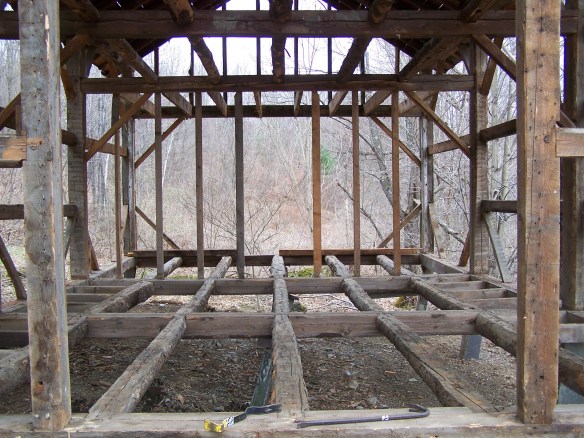“Mr. Perry procured a deed of one of the original proprietors of the town of Tinmouth in 1777 of a large piece of land, then in that town, now Middletown.” So begins the story of one of our most magnificent barn frames for sale.

How do we know this?
Because this history of our very own Middletown Springs is recorded in a series of lectures that were delivered by Barnes Frisbie, a resident of the nearby town, Poultney Vermont. The lectures were given in 1867. What a treasure of a book, and a true gift to those of us here that seek to find the human and architectural stories in our history!

Frisbie continues the tale: “In the spring of 1778 he (Mr. Perry) shouldered his ax, all he had to bring but the clothes he wore, and took possession of the land. It was the same piece of land long known as the Azor Perry farm, and now owned and occupied by Jonathan Atwater.”
Frisbie tells further of Azor’s clearing of the land and his construction of a simple cabin, which he covered with wooden poles and bark. He made himself a bedstead of poles and elm bark. He managed to get a cow the first summer, “which he wintered on brows; that is, he cut down trees and the cow ate the tops.” Imagine the hardship and fortitude needed to fashion a house and fields with just an axe!
In 1779, Perry was married in Bennington, Vermont. In the book from 1867, we are told that, “He had managed, in the year before he was married, to save enough to get a calico wedding dress for his wife, and some few indispensable articles of household furniture to commence with.”
Azor Perry was apparently a renowned and fearless hunter. There are stories told—no doubt growing with each telling around the tavern table not far from his homestead—of his bold encounters with bears. In one of these tales, Perry was called on by his neighbors to help with a particularly troublesome bear that was killing sheep and hogs, and damaging the crops on West Street. A great deal of effort had been made to kill this bear, but the creature had alluded all attempts thus far. The neighbors decided to enlist the help of Azor Perry, and he agreed.
After asking for the help of one other man, Perry headed into the corn field while a small crowd watched at a distance. He told his companion to go closer to the bear, shoot at it, and then run back. “If you kill it, very well. If not, he will be after you. Run behind me—I will stand here.”
Indeed, the bear was wounded, and in a rage, it ran at Perry. The story goes that Azor cooly stood his ground until the bear was just twenty yards away, and then fired. The flintlock gun misfired! Again and again, Perry snapped the trigger as the bear advanced, finally getting the gun to fire just as the bear reached him. As told in the 1867 lecture, “In this affair, he did not appear to manifest any fear or any other feelings except that we was vexed at his gun.” This incident happened on the Buxton Farm, which is just across the brook from our Green Mountain Timber Frames shop.
Azor Perry had eleven children, and one of his daughters married a man named Jonathan Atwater. Together they developed the land further, building a corn barn and a cider press. The corn barn is mentioned in the fabulous 1867 book as being located between the Atwater house and cider mill.
The corn barn fell on hard times in recent decades, due to neglect and a leaky roof. Green Mountain Timber Frames purchased the structure, disassembled it, and we are now delighted to have the restored frame standing at our shop property.
Here is a photo of the frame when it was being disassembled at its original location:

It sat on stone piers high above the ground. This was because corn and grain were stored inside, and the elevation helped to keep rodents at bay. Extra support beams were added along the eve walls where vertical bins held the weighty corn as it dried.
Reerecting the Atwater Timber Frame
We re-erected the frame this summer. We started setting the sills for the barn at 6:30 in the morning, and had the main cube of the frame up by lunchtime.
Here is a photo of the barn’s most recent raising day:

We set the timber-framed deck on temporary wooden piers and leveled it.
Then the bents were raised one by one, and the top plates and braces installed at the eve:

Rafters were put in place, and we could really see this structure taking shape again.
We have put a roof on the Atwater Corn Barn, and applied siding. It is a beautiful space!

The barn was originally used to store and dry corn on the cob, and it also had one bay dedicated to living space- presumably for seasonal farm help. I envision the future use of this barn to be a cabin, a space for writing or art, or as a traditional farm outbuilding once more.
I hope that we have done honor to the courage and fortitude of Azor Perry and his son-in-law Jonathan Atwater with our restoration of this barn. I recently visited the grave of Jonathan Atwater here in our cemetery.

This barn is for sale!
You can see more photos of the 18×30 barn as well as drawings of the space here.
Please let us know if you are interested in the Atwater Corn Crib or another one of our historic barns.
– Luke and the Green Mountain Timber Frames team
tel:1-802-774-8972
luke@GreenMountainTimberFrames.com



It is a really great site!So much useful info and handy ideas, thanks a lot =)